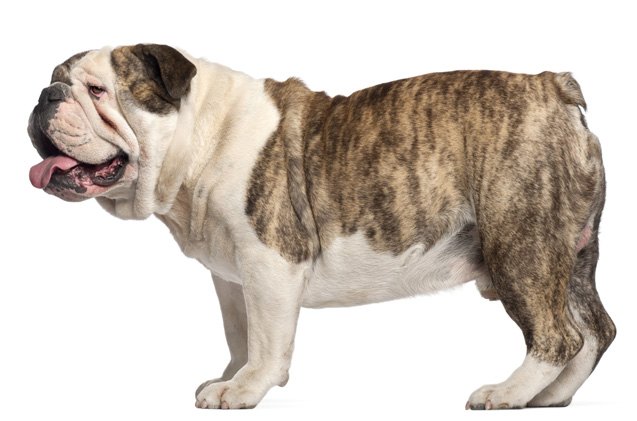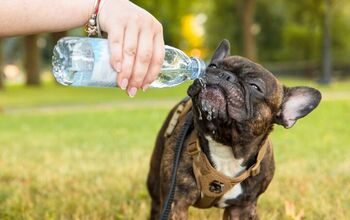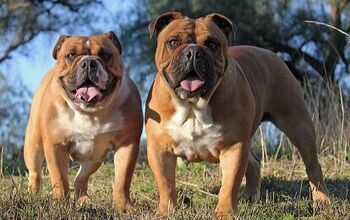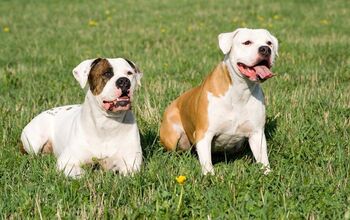Bulldog


About Bulldog
If there’s a better breed of dog that serves as a better name for football teams, we’d like to hear it. The Bulldog – also sometimes known as the English or British Bulldog – is an instantly recognizable breed that resembles a large Pug. Its large head and short legs can make for a cute playmate.
While many people associate the word “bulldog” with fierce fighters, actual Bulldogs can be quite friendly, despite a reputation for stubbornness. Bulldogs will also appear in a number of colors, from light brown and white to black and white.
Many Bullys, as they are called, are famous for a “sourpuss” expression on their faces, but if you can look past its looks and into its personality, you’ll find a worthwhile pet and even better friend. Although they don’t quite make for a great lapdog, they can be a fun dog to take for walks and to play with when they’re in a particularly giddy mood.
As the name of English or British Bulldog suggests, Bulldogs are from England. Around 1500 AD, you’ll find the earliest known mentions of this dog, although the old spelling labelled them as Bolddogges or Bondogges. In the 1600s, the first appearances of the modern spelling of Bulldog first took place, suggesting that these dogs were around in their relatively modern form for quite some time.
Bullys could be used for brutal purposes early on, including bull bating and dog fighting, and as a consequence the modern bulldog generally has a fearlessness about it. After dog fighting was banned in Britain, the Bulldog became more prevalent in the Americas until a resurgence of breeding in Britain led to the modern-day breed that we’re familiar with today. Modern Bullys are typically tamer than were its in-fighting ancestors.
Bulldogs can be quite friendly, despite a reputation for stubbornness.
Although Bullys have been around quite some time, their ancestry is a bit disputed. Some people believe that Bulldogs come from a three-dog mix that included Pugs and Spanish dogs.
Bulldogs typically enjoy a normal diet for dogs of their size and will enjoy a treat like bacon or sausage or even cheap meats that you might have readily available. Since Bulldogs are not great exercisers, it’s important not to over feed them.
Bulldogs are highly responsive to training, which is part of the reason they were made into dog fighters and bull baiters centuries ago. Training this breed does not require a lot of wrestling or excessive dog handling, and in fact sometimes well-trained Bullys might be used to assist other dogs in training.
The Bulldog makes a worthwhile pet and even better friend.
Weighing roughly 40-50 pounds depending on height and gender, Bulldogs are a classic example of a relatively mid-sized dog. The large head and torso of the Bully contrasts with the smaller legs and this can lead to some health problems later on in a Bulldog’s life.
Bulldogs can be presented as having complex personalities, perhaps a sign of their somewhat tainted past. Since Bullys were used for some brutal activities like dog fighting and bull baiting (a process in which Bulldogs would be matched up against bulls), it might be argued that Bulldogs have had the fear “bred” out of them.
This has given rise to using the Bulldog as a mascot, particularly in the United States, where Fresno State University in California and the University of Georgia both use the breed as their mascot.
With today’s Bully, a stubborn but sometimes playful and often friendly temperament can be expected. Bulldogs are also known for having a unique, battle-ready posture (which partially explains their usefulness as mascots) that gives the Bulldogs a good deal of poise around both people and other dogs.
Bulldogs have the ideal dog personality, according to Bully lovers, and are classic examples of dogs that might be considered good for city living: they’re easy to get along with, low-maintenance, and their coat is not difficult to maintain. Being friendly dogs, this breed usually sound meaner than they really are.
The leading cause of death in Bulldogs is cardiac-related, but cancer and old age are also common causes. Hip dysplasia, very common in larger dogs, is most common in this breed, which means you won’t want to over exercise your Bulldog through the years if you don’t want to give them joint damage. Because of the makeup of the Bulldog – with its high amount of upper-body weight as opposed to lower-body – joint problems can always be an issue, particularly in a Bulldog’s old age.
Bulldogs can also be afflicted with “Cherry Eye,” although this condition can be fixed by a veterinarian. It’s also important to remember that Bulldogs can be very sensitive to heat and should be kept in the shade and given plenty of water during summer months.
Different studies put the lifespan of the Bulldog anywhere from 6-12 years. Many estimates suggest that Bulldogs will live around 10-12 years.
Bulldogs are a low-exercise dog. This is not to say that they should do without it completely, but generally getting your Bulldog moving on a regular basis is all you’ll really need to consider. Unlike other dogs that need to be worn out, a Bully is perfectly comfortable lazing with you on a Sunday afternoon. If you are physically incapacitated and wonder about walking a dog, a Bulldog might be a good choice of breed for you.
With today’s Bulldogs, a stubborn but sometimes playful and often friendly temperament can be expected.
The American Kennel Club describes Bulldogs as: “known for their loose-jointed, shuffling gait and massive, short-faced head, the Bulldog is known to be equable, resolute and dignified.”
A low-maintenance coat is another reason Bulldogs can be considered a low-maintenance dog. Its coat is usually short and doesn’t vary wildly in color.
Puppies can be rambunctious and fearless but should not be over exercised as this could lead to problems with joints later in life.
Photo credit: Eric Isselee/Shutterstock

Amy Tokic, Editor of PetGuide.com, is a passionate animal lover and proud pet parent of Oscar, a Shih Tzu/Chihuahua cross, and Zed, a Japanese Chin. Her love of animals began in kindergarten, when she brought her stuffed dog Snoopy into class with her every day. Now, she writes about her adventures in pet ownership and tirelessly researches products, news and health related issues she can share with other animal enthusiasts. In her free time, Amy loves perusing used book and record stores, obsessing over the latest pet products available and chasing squirrels with wild abandon (a habit attributed to spending too much time with her pooches).
More by Amy Tokic

























